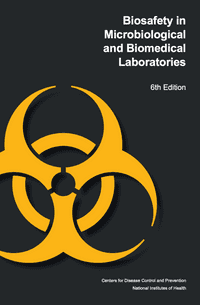Biosafety in Microbiological and Biomedical Laboratories
[CDC BMBL, 6th ed.]
Biosafety in Microbiological and Biomedical Laboratories (BMBL) recommends biosafety best practices for work conducted in biomedical and clinical laboratories. The underlying principles of this guidance are containment and risk assessment. BMBL is a foundational document for biosafety in the United States and serves as an example for countries around the world.
SUMMARY
Biosafety in Microbiological and Biomedical Laboratories (BMBL), 6th edition, is a proctol-driven containment and risk assessment document that advises on best practices for biosafety and risk mitigation in laboratories. In addition to a biological risk assessment, the document also covers principles of biosafety, laboratory biosafety level criteria, animal biosafety, laboratory biosecurity, and occupational health support for researchers. The 6th edition, published in June 2020, includes some revised sections, agent summary statements, and four new appendices: inactivation and verification, laboratory sustainability, large-scale biosafety, and clinical laboratory biosafety.
BMBL is published by the United States Centers for Disease Control and Prevention (US CDC) and the National Institutes of Health (NIH), in collaboration with over 200 experts from across the U.S. BMBL has been a foundational document for biosafety in the United States since it was first published in 1984, and has also served as a guide in many other countries. The document is updated approximately every 10 years and is published in English.


..png)
